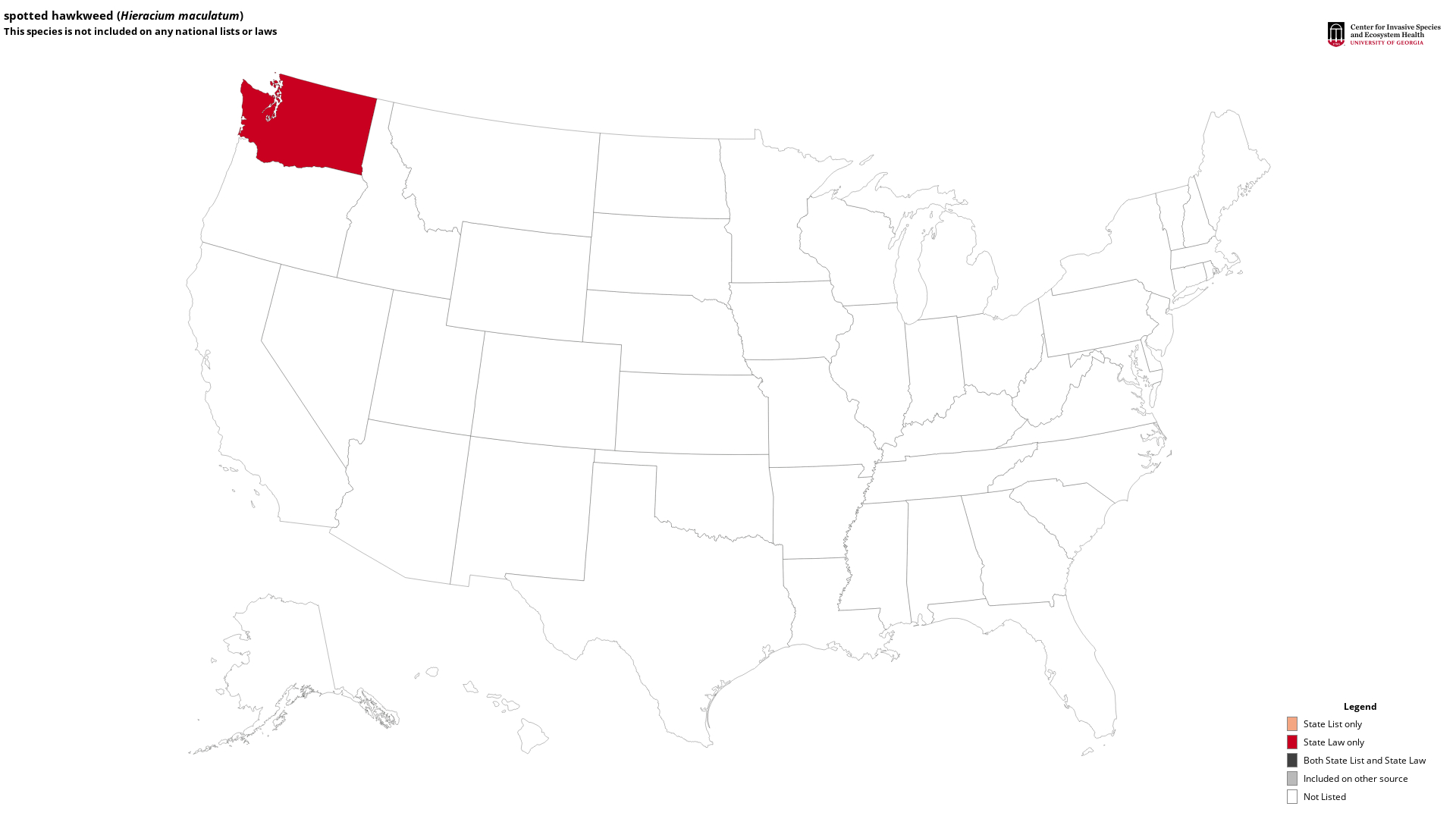spotted hawkweed
(Hieracium maculatum)
This species is Introduced in the United States
Overview:
Spotted hawkweed is a member of the Aster Family and native to Europe. It is a fibrous rooted, perennial herb with milky latex in the stems and leaves. Spotted hawkweed reproduces by seed, and short, stout rhizomes.2It lacks stolons.1 Seeds are produced by apomixis - asexually - as non-native hawkweeds are polyploids (n=9), as opposed to the native diploid hawkweeds. Occasional sexual reproduction occurs, facilitating out-crossing and hybridization.1
Non-native hawkweeds exhibit many characteristics of an invasive plant: high seed production and germination rates, asexual seed production, wind-dispersed seed, vegetative reproduction via rhizomes, stolons, and root fragments, and rapid growth.1 A few invasive hawkweed species are popular ornamentals. All of these characteristics facilitate rapid colonization and monopolizing of resources. An undetected patch of hawkweed has great potential to become an un-eradicable infestation.
Spotted hawkweed is occasionally cultivated as an ornamental due to the purple-mottled leaves.
Hawkweeds develop a low rosette of basal leaves before producing a flowering stem. Dandelion-like flowers are borne at the ends of stems and when mature produce a dandelion-like puffball of seeds that are wind-dispersed.
Habitat
Hawkweeds prefer well-drained, coarse textured soils, moderately low in organic matter, in mesic habitats.1
Identification:
Stems: Stems are erect and usually solitary, with or without bristly or stellate hairs.2Plants grow 20-80 cm tall.1
Leaves: Basal leaves are well developed and persistent. Leaves are narrowly to broadly elliptic, stalked, with toothed edges, and 1.5-15 cm long, 0.3-2.0 cm wide.2 Upper surface are purple-mottled or blotched.1Upper leaf surfaces have non-glandular hairs or are glabrous, and sometimes stellate hairs on lower surfaces. Stem leaves are similar and number 2-4 or rarely up to 8, and reduced upwards on stems.2
Flowers: Clusters of several to numerous flowers with strap-shaped yellow petals occur at the ends of stems. The flower stalks bear glandular or non-glandular, stellate hairs. The involucres are 8-11 mm tall, the bracts graduated, obtuse to sharply pointed, with glandular or non-glandular, stellate hairs. Fruits are achenes 2 mm long with a tawny pappus.2
Prevention:
Learning to recognize hawkweeds from the many yellow-flowered members of the Aster Family is the key to prevention. Hairs are an important characteristic of non-native hawkweeds and also in distinguishing between species. Long-term management of hawkweeds requires maintaining healthy forbs and grasses - fertilization of desirable vegetation can result in out-competition of hawkweeds. Re-seed disturbance in areas susceptible to hawkweed invasion.
Control:
Grazing: Unknown. Invasive plants should never be considered as forage.
Mechanical: Mowing before flowering will prevent seed production of taller plants but will not prevent reproduction via rhizomes. Hand digging of small infestations may be effective, taking care to remove all root and rhizome pieces.
Chemical: Hexazinone, 2,4-D, and glyphosate are registered for use on Hieracium spp./hawkweeds. Always check product labels to ensure the herbicide is registered for use on the target plant in Canada by the Pest Management Regulatory Agency. Consult your local Agricultural Fieldman or Certified Pesticide Dispenser for more information.
Biological: None researched to date specifically for Hieracium maculatum.
1Wilson, Linda. Key to Identification of Invasive and Native Hawkweeds in the Pacific Northwest. British Columbia Ministry of Forests and Range, Forest Practices Branch, Invasive Alien Plant Program.
2Hieracium maculatum. The Illustrated Flora of British Columbia. http://linnet.geog.ubc.ca/Atlas/Atlas.aspx?sciname=Hieracium maculatum&redblue=Both&lifeform=7. Accessed August 6, 2014.
Selected Images
Maps
State Lists - This map identifies those states that have this species on their invasive species list or law.
Taxonomic Rank
| Domain: Eukarya |
| Kingdom: Plantae |
| Phylum: Magnoliophyta |
| Class: Magnoliopsida |
| Superorder: Asteranae |
| Order: Asterales |
| Family: Asteraceae |
| Subfamily: Cichorioideae |
| Tribe: Cichorieae |
| Genus: Hieracium |
| Hieracium maculatum |
References
Common Name Reference: USDA, NRCS. 2010. The PLANTS Database. National Plant Data Center, Baton Rouge, LA, USA.
Scientific Name Reference: USDA, NRCS. 2010. The PLANTS Database. National Plant Data Center, Baton Rouge, LA, USA.

